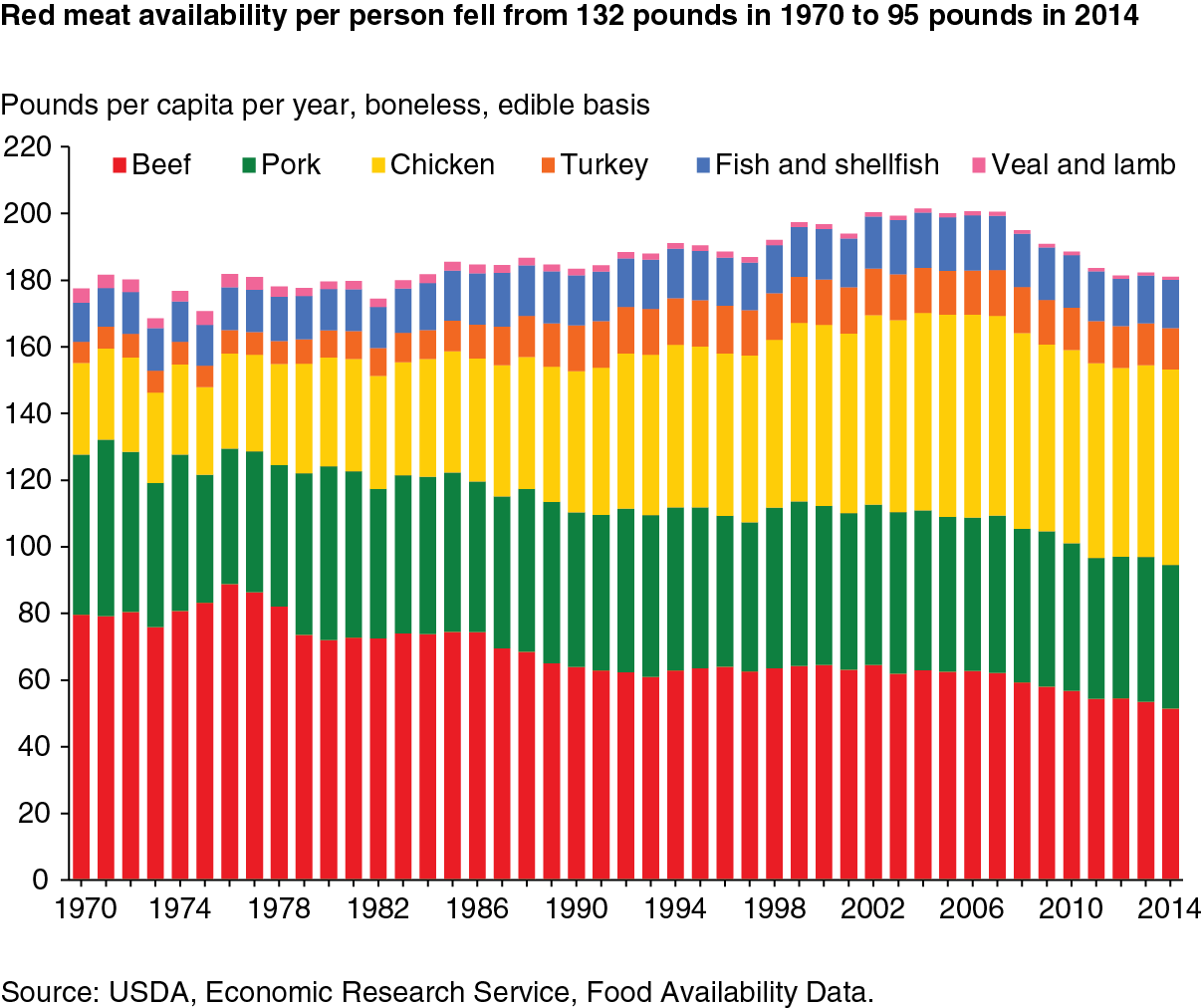U.S. Per Capita Availability of Red Meat, Poultry, and Fish Lowest Since 1983
- by Jeanine Bentley
- 2/6/2017
According to ERS’s food availability data, the annual per capita supply of total red meat (beef, pork, veal, and lamb), poultry (chicken and turkey), and fish/shellfish available for consumption in the United States has fallen over the last 7 years after reaching 200 pounds in the mid-2000s. In 2014, aggregate red meat, poultry, and fish/shellfish availability on a boneless, edible basis fell to 181 pounds per person, the lowest level since 1983. ERS calculates food availability in a given year by totaling domestic production, imports, and beginning stocks and subtracting exports, ending stocks, and farm, industrial, and other nonfood uses. Per capita availability is calculated by dividing the annual availability by the U.S. population for that year.
While the decline in beef availability from its peak of 88.8 pounds per person in 1976 to 51.5 pounds per person in 2014 is not a new story, availability of other red meats has dropped as well. Pork availability is down from an average 47.0 pounds per person from 1979 to 2010 to 43.1 pounds per person in 2014, and veal and lamb availability is down from 4.2 pounds per person in 1970 to 1 pound per person in 2014. Fish and shellfish availability, up from around 12 pounds per person in 1970, has fluctuated between 14.1 and 16.5 pounds since 1984 and was 14.5 pounds per person in 2014.
On the poultry side, the story is more mixed. Turkey availability grew in most years between 1970 and 1996, reaching 14.3 pounds per person before declining to 12.4 pounds per person in 2014. Availability of chicken, on the other hand, has steadily increased since 1970, reaching 58.7 pounds per person in 2014. Despite the increase in chicken, red meat still accounts for the largest share of red meat, poultry, and fish/shellfish availability at 53 percent, compared with 39 percent for poultry and 8 percent for fish and shellfish.
Multiple supply and demand factors have influenced trends in per capita availability of red meat, poultry, and fish. On the supply side, high crop prices, which led to high feed costs and subsequently higher beef prices over the 2006-15 decade, are partly responsible for reduced red meat production. Efficiencies in chicken production have led to lower bird mortality rates and a higher average live weight per broiler, increasing chicken availability. On the demand side, beef and pork’s higher retail price compared to chicken and turkey might also have contributed to poultry’s growing popularity. Average retail prices for beef and pork in 2015 were $5.73 per pound and $3.89 per pound, respectively, while chicken and turkey sold for $2.16 per pound and $1.51 per pound.
This article is drawn from:
- Food Availability (Per Capita) Data System. (n.d.). U.S. Department of Agriculture, Economic Research Service.
- Kantor, L. (2016, October 3). Americans’ Seafood Consumption Below Recommendations. Amber Waves, U.S. Department of Agriculture, Economic Research Service.
- Badau, F. (2016, September 6). U.S. Beef and Pork Consumption Projected To Rebound. Amber Waves, U.S. Department of Agriculture, Economic Research Service.


